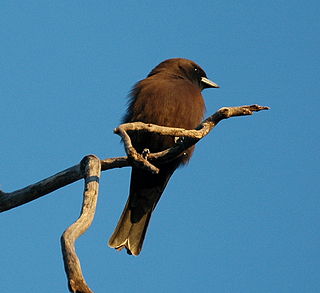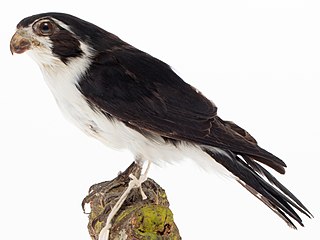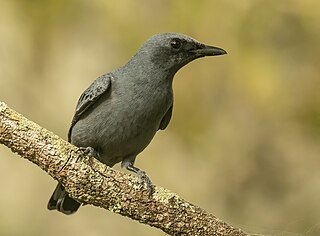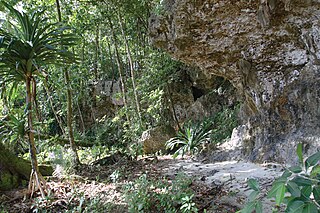
Woodswallows are soft-plumaged, somber-coloured passerine birds in the genus Artamus. The woodswallows are either treated as a subfamily, Artaminae, in an expanded family Artamidae, or as the only genus in that family. The generic name, which in turn gives rise to the family name, is derived from the Ancient Greek artamos, meaning butcher or murder. The name was given due to their perceived similarity to shrikes. A former common name for the group was "swallow-starlings".

The white-breasted woodswallow is a medium-sized passerine bird which breeds from the Andaman Islands east through Indonesia and northern Australia. The name "woodswallow" is a misnomer as they are not closely related to true swallows. Instead, they belong to the family Artamidae, which also includes butcherbirds, currawongs and the Australian magpie.

The white-browed woodswallow is a medium-sized (~19 cm) passerine bird endemic to Australia. The white-browed woodswallow has very distinctive plumage consisting of white brow over a black head with the upper body being a deep blue-grey and with a chestnut under body. The females are paler then the males. The white-browed woodswallow has a bifurcated (divided) tongue like most woodswallows.

The little woodswallow, is a bird patchily distributed over much of mainland Australia, avoiding only the driest deserts and the area within about 300 kilometres of the southern coastline, and showing a preference for rugged terrain around inland ranges.

The black-faced woodswallow is a woodswallow of the genus Artamus native to Australia, New Guinea and the Sunda Islands, including Timor. It is 18–19 cm (7.1–7.5 in) long and is the most widespread species in the family Artamidae. Woodswallows have a soft call with chiff, chap and chattering calls which can include vocal mimicry

The ashy woodswallow, sometimes also called the ashy swallow-shrike, is a woodswallow which is found in south Asia. Like other woodswallows, it has a short curved bill, a short square tail and long wings. It is usually seen perched in groups, high on powerlines, tall bare trees and most often in areas with a predominance of tall palm trees.

The white-throated bush chat, also known as Hodgson's bushchat, is an Old World flycatcher in the genus Saxicola. It is IUCN Red Listed as Vulnerable as of 2018. In 2001, the global population has been estimated at between 3,500 and 15,000 individuals. The major threat appears to be the rapid loss of grasslands in its wintering areas. It winters in the Nepal and Indian Terai and in the Dooars. In this region, it has been recorded in Jim Corbett, Shuklaphanta, Chitwan, Kaziranga, and Manas National Parks and in Lumbini Crane Sanctuary. It prefers wet and dry grasslands, reeds and tamarisks along riverbeds, and also occurs in sugarcane fields. In spring and summer, it breeds in the alpine or sub-alpine meadows and scrub in the mountains of Mongolia and adjacent parts of Russia. The white-throated bush chats is insectivorous.

The dusky woodswallow is a bird species of forests and woodlands in temperate and subtropical regions, extending into tropical areas around the Atherton Tableland, in eastern and southern Australia. The global population of the species has as yet not been formally confirmed, but it has been officially rated in the range of 'Least Concern', according to the BirdLife International in 2004. As such, the bird could be described as common in its local habitat.

The pied falconet, is a species of bird of prey in the family Falconidae. It is found in Bangladesh, Bhutan, China, Hong Kong, India, Laos, and Vietnam. Its natural habitat is temperate forests.

The pink-legged rail, also known as the New Britain rail, is a species of bird in the family Rallidae.

The great woodswallow, also known as the greater woodswallow, giant woodswallow or New Guinea woodswallow is a species of bird in the family Artamidae. As its name implies, it is the largest member of the genus Artamus, averaging 20 centimetres (7.87 in) in length and 61 grams (2.2 oz) in mass. In appearance the great woodswallow is very similar to the more widespread white-breasted woodswallow but can be distinguished by its darker black upper side plumage and by the presence of a semi-oval black patch below the throat.

The Fiji woodswallow is a species of woodswallow in the family Artamidae. It is endemic to most of the islands of Fiji, although it is absent from Kadavu Archipelago and the Lau Archipelago. The species was once considered a race of the white-breasted woodswallow, which breeds from Australia, New Caledonia and Vanuatu through to Borneo and the Philippines. Some authors retain it in that species.

The ivory-backed woodswallow is a species of bird in the family Artamidae. It is endemic to Sulawesi, Indonesia.

Masked woodswallow is a species of bird in the family Artamidae.

The Sahul cicadabird, previously known as the common cicadabird or slender-billed cicadabird, is a species of passerine bird in the family Campephagidae. It is found in Australia, New Guinea and the Bismarck Archipelago. Its natural habitats are temperate forest and subtropical or tropical moist lowland forest. The species is placed in the reinstated genus Edolisoma by most authors. The common cicadabird was described as a "great speciator" by Mayr & Diamond (2001); and Pedersen et al. (2018) described how this species rapidly colonized and diversified across the Indo-Pacific island region and Australia in the Pleistocene.
The Bismarck cicadabird is a species of bird in the family Campephagidae. It is endemic to islands in the Bismarck Archipelago. It was previously considered to be conspecific with the common cicadabird.

Artamidae is a family of passerine birds found in Australia, the Indo-Pacific region, and Southern Asia. It includes 24 extant species in six genera and three subfamilies: Peltopsinae, Artaminae and Cracticinae. Artamids used to be monotypic, containing only the woodswallows, but it was expanded to include the family Cracticidae in 1994. Some authors, however, still treat the two as separate families. Some species in this family are known for their beautiful song. Their feeding habits vary from nectar sucking (woodswallows) to predation on small birds.

The New Britain-New Ireland lowland rain forests is a tropical moist forest ecoregion in Papua New Guinea. The ecoregion covers the lowland rain forests of New Britain, New Ireland, and nearby islands in the Bismarck Archipelago.


















